Majid Safari
A Comprehensive Comparison between Terahertz and Optical Wireless Communications
Mar 29, 2025



Abstract:This paper presents a comprehensive quantitative comparison between Terahertz (THz) communication (TeraCom) and optical wireless communication (OWC) technologies, focusing on both indoor and outdoor environments. We propose a comparison method for TeraCom and vertical-cavity surface-emitting laser (VCSEL)-based OWC in indoor scenarios, incorporating misalignment effects by modeling the THz antenna radiation pattern within a multi-ray THz channel model and using a Gaussian beam model for VCSEL-based OWC. Unified beamwidth parameters allow for a detailed analysis of misalignment impact on both systems. Furthermore, we develop power consumption models for each technology, integrating key parameters such as THz phase noise, VCSEL non-linearities, and photodetector bandwidth-area tradeoffs. These models enable an in-depth analysis of energy efficiency in indoor environments, including multi-transmitter coverage scenarios. For outdoor scenarios, we summarize existing stochastic channel models addressing path loss, pointing errors, and small-scale fading for free space optics (FSO) and THz links. We then apply these models to unmanned aerial vehicle (UAV) applications to assess performance in dynamic conditions. Our results provide critical insights into the suitability of each technology for various deployment scenarios.
A Novel Terabit Grid-of-Beam Optical Wireless Multi-User Access Network With Beam Clustering
Apr 05, 2024

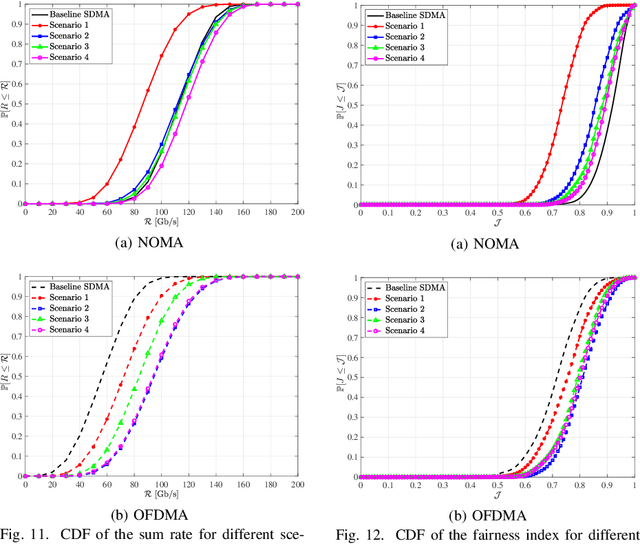
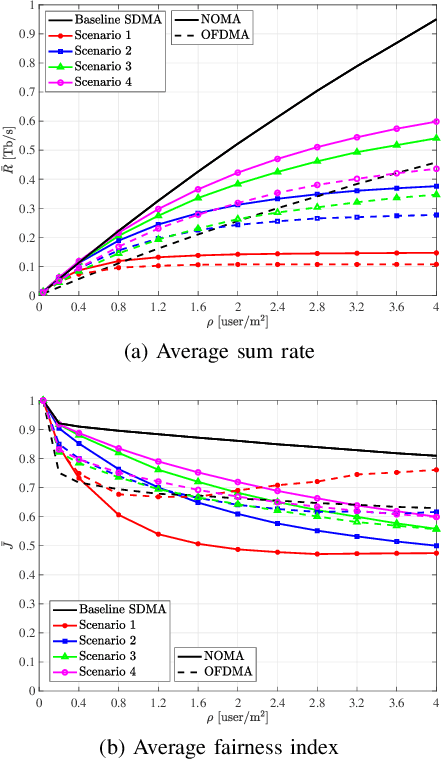
Abstract:In this paper, we put forward a proof of concept for sixth generation (6G) Terabit infrared (IR) laser-based indoor optical wireless networks. We propose a novel double-tier access point (AP) architecture based on an array of arrays of vertical cavity surface emitting lasers (VCSELs) to provide a seamless grid-of-beam coverage with multi-Gb/s per beam. We present systematic design and thorough analytical modeling of the AP architecture, which are then applied to downlink system modeling using non-imaging angle diversity receivers (ADRs). We propose static beam clustering with coordinated multi-beam joint transmission (CoMB-JT) for network interference management and devise various clustering strategies to address inter-beam interference (IBI) and inter-cluster interference (ICI). Non-orthogonal multiple access (NOMA) and orthogonal frequency division multiple access (OFDMA) schemes are also adopted to handle intra-cluster interference, and the resulting signal-to-interference-plus-noise ratio (SINR) and achievable data rate are derived. The network performance is studied in terms of spatial distributions and statistics of the downlink SINR and data rate through extensive computer simulations. The results demonstrate that data rates up to 15 Gb/s are achieved within the coverage area and a properly devised clustering strikes a balance between the sum rate and fairness depending on the number of users.
Single-Photon Counting Receivers for 6G Optical Wireless Communications
May 16, 2023



Abstract:Optical wireless communication (OWC) offers several complementary advantages to radio-frequency (RF) wireless networks such as its massive available spectrum; hence, it is widely anticipated that OWC will assume a pivotal role in the forthcoming sixth generation (6G) wireless communication networks. Although significant progress has been achieved in OWC over the past decades, the outage induced by occasionally low received optical power continues to pose a key limiting factor for its deployment. In this work, we discuss the potential role of single-photon counting (SPC) receivers as a promising solution to overcome this limitation. We provide an overview of the state-of-the-art of OWC systems utilizing SPC receivers and identify several critical areas of open problems that warrant further research in the future.
Design and Optimisation of High-Speed Receivers for 6G Optical Wireless Networks
Dec 30, 2022Abstract:To achieve multi-Gb/s data rates in 6G optical wireless access networks based on narrow infrared (IR) laser beams, a high-speed receiver with two key specifications is needed: a sufficiently large aperture to collect the required optical power and a wide field of view (FOV) to avoid strict alignment issues. This paper puts forward the systematic design and optimisation of multi-tier non-imaging angle diversity receivers (ADRs) composed of compound parabolic concentrators (CPCs) coupled with photodiode (PD) arrays for laser-based optical wireless communication (OWC) links. Design tradeoffs include the gain-FOV tradeoff for each receiver element and the area-bandwidth tradeoff for each PD array. The rate maximisation is formulated as a non-convex optimisation problem under the constraints on the minimum required FOV and the overall ADR dimensions to find optimum configuration of the receiver bandwidth and FOV, and a low-complexity optimal solution is proposed. The ADR performance is studied using computer simulations and insightful design guidelines are provided through various numerical examples. An efficient technique is also proposed to reduce the ADR dimensions based on CPC length truncation. It is shown that a compact ADR with a height of $\leq0.5$ cm and an effective area of $\leq0.5$ cm$^2$ reaches a data rate of $12$ Gb/s with a half-angle FOV of $30^\circ$ over a $3$ m link distance.
SPAD-Based Optical Wireless Communication with ACO-OFDM
Oct 25, 2022



Abstract:The sensitivity of the optical wireless communication (OWC) can be effectively improved by employing the highly sensitive single-photon avalanche diode (SPAD) arrays. However, the nonlinear distortion introduced by the dead time strongly limits the throughput of the SPAD-based OWC systems. Optical orthogonal frequency division multiplexing (OFDM) can be employed in the systems with SPAD arrays to improve the spectral efficiency. In this work, a theoretical performance analysis of SPAD-based OWC system with asymmetrically-clipped optical OFDM (ACO-OFDM) is presented. The impact of the SPAD nonlinearity on the system performance is investigated. In addition, the comparison of the considered scheme with direct-current-biased optical OFDM (DCO-OFDM) is presented showing the distinct reliable operation regimes of the two schemes. In the low power regimes, ACO-OFDM outperforms DCO-OFDM; whereas, the latter is more preferable in the high power regimes.
Spatial and Wavelength Division Joint Multiplexing System Design for Visible Light Communications
Sep 20, 2022
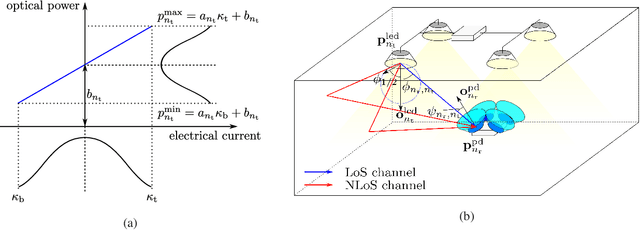
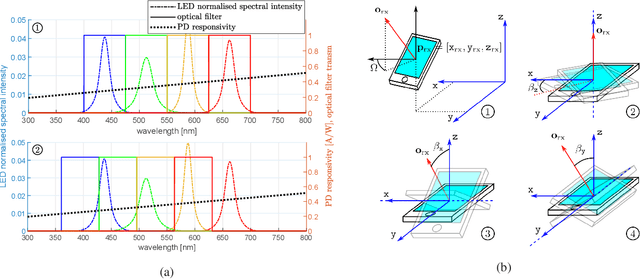

Abstract:The low-pass characteristics of front-end elements including light-emitting diodes (LEDs) and photodiodes (PDs) limit the transmission data rate of visible light communication (VLC) and Light Fidelity (LiFi) systems. Using multiplexing transmission techniques, such as spatial multiplexing (SMX) and wavelength division multiplexing (WDM), is a solution to overcome bandwidth limitation. However, spatial correlation in optical wireless channels and optical filter bandpass shifts typically limit the achievable multiplexing gain in SMX and WDM systems, respectively. In this paper, we consider a multiple-input multiple output (MIMO) joint multiplexing VLC system that exploits available degrees-offreedom (DoFs) across space, wavelength and frequency dimensions simultaneously. Instead of providing a new precoder/post-detector design, we investigate the considered joint multiplexing system from a system configuration perspective by tuning system parameters in both spatial and wavelength domains, such as LED positions and optical filter passband. We propose a novel spatial clustering with wavelength division (SCWD) strategy which enhances the MIMO channel condition. We propose to use a state-of-the-art black-box optimization tool: Bayesian adaptive direct search (BADS) to determine the desired system parameters, which can significantly improve the achievable rate. The extensive numerical results demonstrate the superiority of the proposed method over conventional SMX and WDM VLC systems.
Optimal Power Allocation for Integrated Visible Light Positioning and Communication System with a Single LED-Lamp
Aug 30, 2022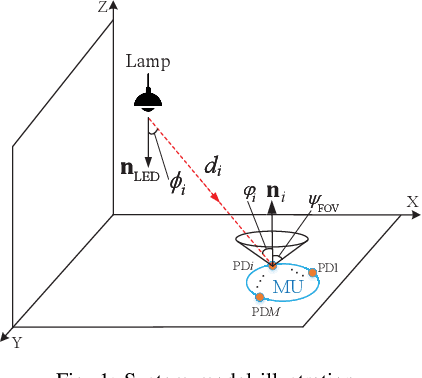

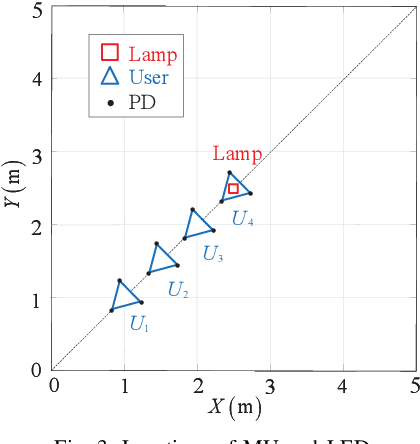
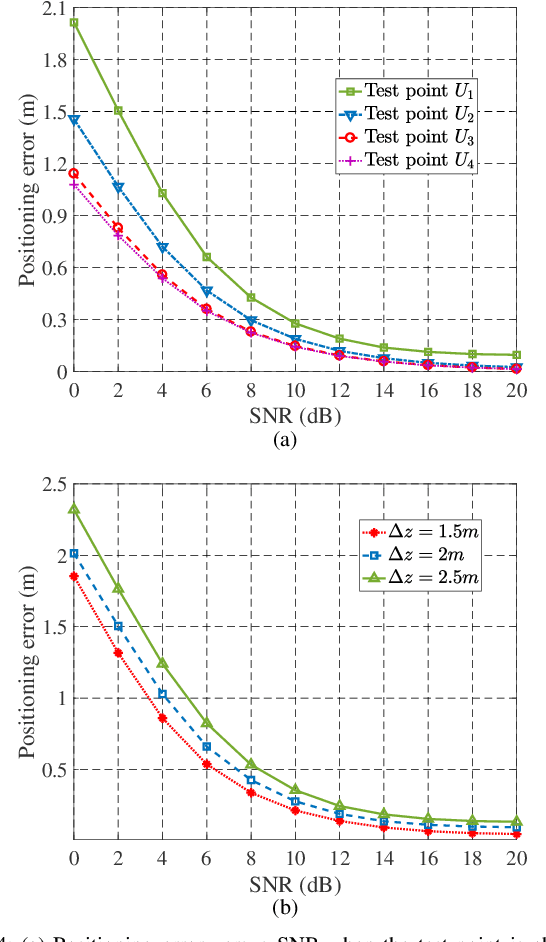
Abstract:In this paper, we investigate an integrated visible light positioning and communication (VLPC) system with a single LED-lamp. First, by leveraging the fact that the VLC channel model is a function of the receiver's location, we propose a system model that estimates the channel state information (CSI) based on the positioning information without transmitting pilot sequences. Second, we derive the Cramer-Rao lower bound (CRLB) on the positioning error variance and a lower bound on the achievable rate with on-off keying modulation. Third, based on the derived performance metrics, we optimize the power allocation to minimize the CRLB, while satisfying the rate outage probability constraint. To tackle this non-convex optimization problem, we apply the worst-case distribution of the Conditional Value-at-Risk (CVaR) and the block coordinate descent (BCD) methods to obtain the feasible solutions. Finally, the effects of critical system parameters, such as outage probability, rate threshold, total power threshold, are revealed by numerical results.
Multi-User Rate Splitting in Optical Wireless Networks
Jul 23, 2022



Abstract:Optical wireless communication (OWC) has recently received massive interest as a new technology that can support the enormous data traffic increasing on daily basis. Laser-based OWC networks can provide terabits per second (Tbps) aggregate data rates. However, the emerging OWC networks require clusters of optical transmitters to provide uniform coverage for multiple users. In this context, multi-user interference (MUI) is a crucial issue that must be managed efficiently to provide high spectral efficiency. Rate splitting (RS) is proposed as a transmission scheme to serve multiple users simultaneously by splitting the message of a given user into common and private messages, and then, each user decodes the desired message following a certain procedure. In radio frequency (RF) networks, RS provides higher spectral efficiency compared with orthogonal and non-orthogonal transmission schemes. Considering the high density of OWC networks, the performance of RS is limited by the cost of providing channel state information (CSI) at transmitters and by the noise resulting from interference cancellation. In this work, a user-grouping algorithm is proposed and used to form multiple groups, each group contains users spatially clustered. Then, an outer precoder is designed to manage inter-group interference following the methodology of blind interference alignment (BIA), which reduces the requirements of CSI at RF or optical transmitters. For intra-group interference, RS is applied within each group where the users belonging to a given group receive a unique common message on which their private messages are superimposed. Furthermore, an optimization problem is formulated to allocate the power among the private messages intended to all users such that the sum rate of the network is maximized.
Multi-Hop Quantum Key Distribution with Passive Relays over Underwater Turbulence Channels
Jun 13, 2022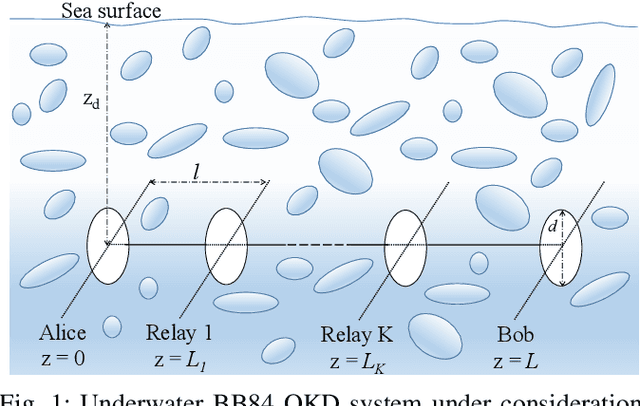
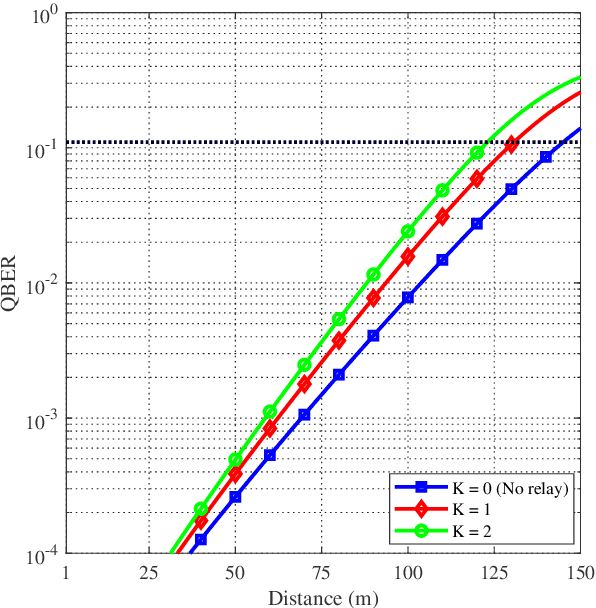
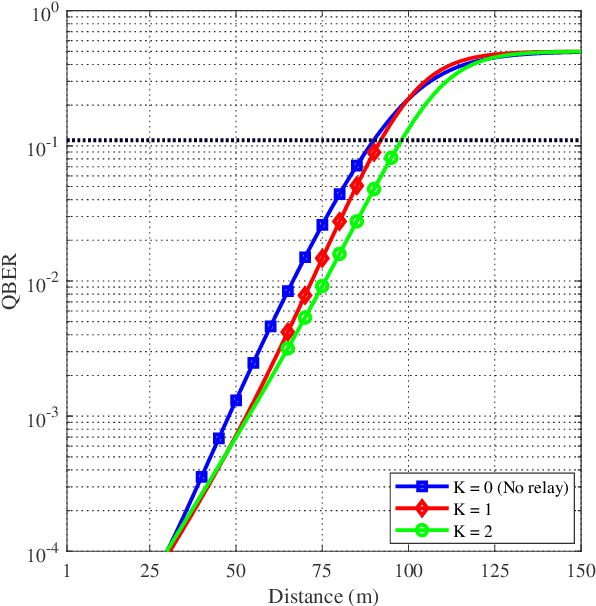
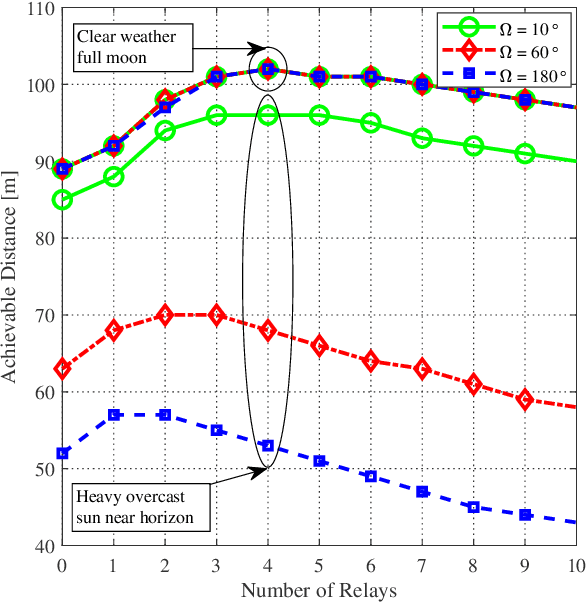
Abstract:Absorption, scattering, and turbulence experienced in underwater channels severely limit the range of quantum communications. In this paper, to overcome range limitations, we investigate a multi-hop underwater quantum key distribution (QKD) where intermediate nodes help the key distribution between the source and destination nodes. We consider deployment of passive-relays which simply redirect the qubits to the next relay node or receiver without any measurement. Based on near-field analysis, we present the performance of relay-assisted QKD scheme in clear ocean under different atmospheric conditions. We further investigate the effect of system parameters (aperture size and detector field-of-view) on the achievable distance.
Performance Analysis of SPAD-Based Optical Wireless Communication with OFDM
Jun 04, 2022



Abstract:In recent years, there has been a growing interest in the use of single-photon avalanche diode (SPAD) in optical wireless communication (OWC). SPAD operates in the Geiger mode and can act as a photon counting receiver obviating the need for a transimpedance amplifier (TIA). Although a SPAD receiver can provide higher sensitivity compared to the traditional linear photodetectors, it suffers from the dead-time-induced nonlinearity. To improve the data rates of SPAD-based OWC systems, optical orthogonal frequency division multiplexing (OFDM) can be employed. This paper provides a comprehensive theoretical analysis of the SPAD-based OWC systems using OFDM signalling considering the effects of signal clipping, SPAD nonlinearity, and signal-dependent shot noise. An equivalent additive Gaussian noise channel model is proposed to describe the performance of the SPAD-based OFDM system. The statistics of the proposed channel model and the analytical expressions of the signal-to-noise ratio (SNR) and bit error rate (BER) are derived in closed forms. By means of extensive numerical results, the impact of the unique receiver nonlinearity on the system performance is investigated. The results demonstrate new insights into different optical power regimes of reliable operation for SPAD-based OFDM systems even well beyond SPAD saturation level.
 Add to Chrome
Add to Chrome Add to Firefox
Add to Firefox Add to Edge
Add to Edge